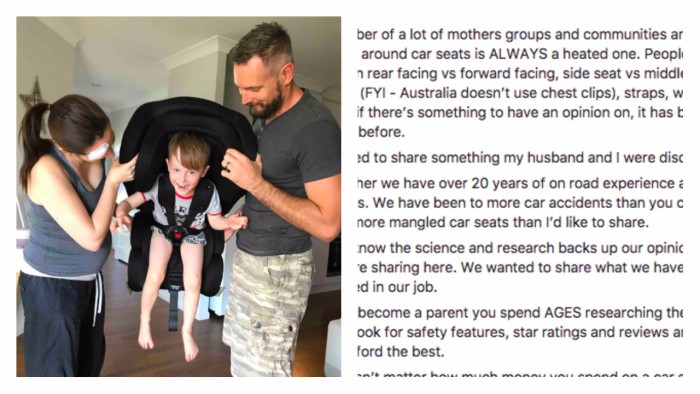- Study Says Most Parents Don’t Use Car Seats In Ride Share Vehicles Like Uber
- This 12-Year-Old Boy Is A Sophomore Aerospace Engineering Major!
- Fire Safety Experts Warn Of Hand Sanitizer Danger After A Mom and Kids Escape House Fire
- Recall Alert: Peaches May Be The Cause Of Salmonella Outbreak, 68 People Ill
- Summer Vacation In The Days Of COVID: Tips To Stay Safe
- How To Safely Grocery Shop During The Coronavirus Pandemic
- Michigan Teen With Vape-Related Illness Undergoes Double Lung Transplant
- Teen Kicks Off Anti-Vaping Campaign From Hospital Bed
- Teenager Receives Life Sentence For Strangling Sister To Death Over A Wi-Fi Password
- Toddler Falls To Death From 11th Deck of Cruise Ship
Paramedics Share Car Seat Safety Advice Every Parent Needs To Hear


When it comes to kids involved in car accidents, there’s a key factor in preventing tragedy — correct car seat use.
An Australian couple, both paramedics, took to Facebook this week to demonstrate exactly how important it is that a child be in a safe car seat with the straps properly adjusted.
The image is pretty breathtaking.
First, note that chest clips are not used in Australia, so that’s why their son’s car seat doesn’t have any. Second, holy smokes.
This is a striking photo and certainly makes a point about the true purpose of a car seat — to make sure a child stays put, no matter what. In order for that to happen, the straps have to be tight. Probably a lot tighter than most parents think.
Kleidon begins her post by acknowledging what a hot-button issue car seats can be in the parenting world. “I’m a member of a lot of mothers groups and communities and the discussion around car seats is ALWAYS a heated one. People give their opinions on rear facing vs forward facing, side seat vs middle seat, chest clip height (FYI – Australia doesn’t use chest clips), straps, wearing jumpers… if there’s something to have an opinion on, it has been discussed before.”
She explains how with a combined 20+ years as paramedics, Kleidon and her husband are in the unique position of having witnessed plenty of kids surviving horrific car wrecks. The one thing all those very fortunate children had in common?
They were properly restrained in a safe car seat.
“Between my husband and I, in our 20 years experience, we have NOT seen a single child harmed in a car accident where the child was restrained in their seat properly. Not a single one,” she writes.
Wow.
The couple dispels the notion that in order for a child to be safe, the car seat should be a pricey one. That’s not how it works. “We’ve seen car seats ejected from vehicles, we’ve seen cars that have rolled over so many times you can barely tell which way is up, we’ve seen accidents where you would be certain there would be no survivors.”
“But in our experience, the biggest difference between a child’s safety hasn’t been if they were in the $600 car seat or the $200 one. It’s been about those straps,” she shares.
Kleidon gives a few pointers for ensuring the straps are pulled tightly enough, like making sure your child can’t pull their arms out and that you can only fit one or two fingers underneath the straps. She also mentions leaving out the puffy winter coats, since all that bulk will certainly prevent a parent from achieving a proper fit with the straps.
Her last bit of advice is where the photo comes in. “Would you be confident in doing THIS to them? Would you be confident in turning your child upside down in their seat?”
It’s horrifying to imagine getting into a car accident with your kids in the back seat, but it’s that imagining that can help parents understand the real purpose and function of a car seat — to hold a child safely in place should the unthinkable occur. If you wouldn’t feel confident turning your child upside down in their car seat, take Kleidon’s advice and give those straps a tug. Also, be sure to research strap placement for your child’s seat and verify that the chest clip and straps are placed correctly.
It could mean the difference between life and death.







0 comments